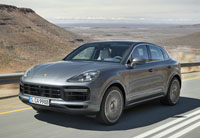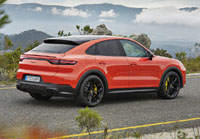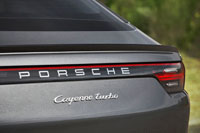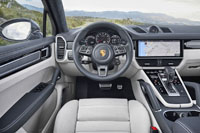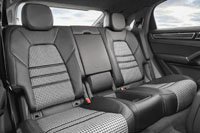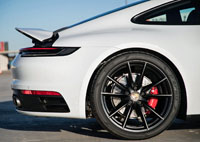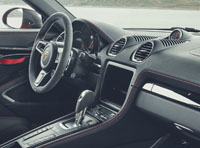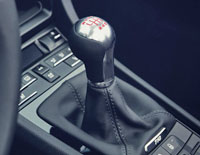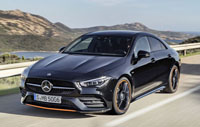
Since arriving on the subcompact luxury scene six years ago, the Mercedes-Benz CLA has been in a constant sparring session with Audi’s A3, but when the challenger from Ingolstadt said so long to its conventionally-powered five-door hatchback and we all said hello to an entirely new four-door sport sedan, the four-ringed brand has enjoyed a slight sales lead over its sporty four-door coupe competitor.
Of course, M-B and Audi aren’t the only two battling it out for entry-level premium car customers, with Mercedes’ very own B-Class MPV luring in plenty each year from its faithful following, not to mention Acura with its ILX sedan, BMW with its 2 Series coupe and convertible, etcetera, but the problems facing this class aren’t as simple as a handful of rivals doing their best to one-up each other anymore, but rather getting noticed in a luxury market that’s a lot more about SUVs than anything that hugs the pavement so closely.
For this reason we’ve all got to give Mercedes a round of applause (or maybe a standing ovation) for courageously hitting back with myriad car models in most every luxury segment while others are fleeing. In fact, Mercedes will soon offer more models within the subcompact luxury sector than some competitors have cars, period. Perhaps we can chalk this up to being in the automotive industry longer than any rival, a reality that provided experience through plenty of changes in market sentiment, or possibly it’s just plain stubbornness, but whatever the reason, this German brand not only offers six sedans, two wagons, seven coupes, and six convertibles for a total of 21 different body styles you can purchase right here in Canada, right now, but on top of these the Stuttgart-based marque will be adding the A-Class sedan later this year, bumping its car count up to 22, a mind-blowing pavement-hugging lineup in an auto market that’s supposedly only purchasing high-riding SUVs these days.

Of course Mercedes-Benz, Canada’s number one-selling luxury automotive retailer, is capable of filling nearly every niche anyone can conjure up because of its enviable brand equity. Build it and they will come, or so the paraphrased saying goes, and for the most part it’s true. Just look at this subcompact luxury car sector that most brands aren’t even participating in. Mercedes’ B-Class has been attracting entry-level buyers since 2005 when it arrived as a 2006 model, while the same Canadian M-B retailers have been selling the CLA since 2013 (check out pricing and more for the current CLA-Class right here on CarCostCanada now), and the new A-Class hatchback since January.
Through the first two months of 2019, Mercedes’ collective subcompact luxury sales (including the B-Class) tallied up to 606 units, which dwarfed the 350 Audi A3s sold into the same market, let alone BMW that only managed to sell 139 2 Series and i3 models during the same two months, and as noted we haven’t even seen sales from the lower priced M-B A-Class sedan kick in, or for that matter this entirely new CLA four-door coupe that will hit the streets this fall, building on a success story that’s been pretty impressive so far.
“With the first CLA we celebrated a huge success by selling some 750,000 vehicles and created a totally new segment with a four-door coupe in the compact class,” says Britta Seeger, Member of the Board of Management of Daimler AG, responsible for Mercedes-Benz Cars Marketing & Sales.

Interestingly, more than two thirds of Canadian CLA buyers were new to Mercedes during that model’s peak sales stint, while it’s also critical to point out that these new M-B owners were seven years younger than the brand’s usual average age of clientele. Later this year Canadians will be given the choice of four recently updated or completely new subcompact models (five if you divide the A-Class into its current hatchback and upcoming sedan body types), with this CLA being the most expressive, and sportiest in the collection, and plenty of these newfound Mercedes owners will more than likely stay with the brand when it comes time to trade in and escalate up to fancier more profitable models within the lineup, as their income increases with age and experience.
“The new CLA is even more emotional and sportier than its predecessor,” continued Seeger. “Coupled with new operating systems, it sets a new benchmark for the entire class.”
There’s a very big reason Mercedes chose the Las Vegas’ Consumer Electronics Show (CES) to debut its new CLA last January, the massive Mercedes-Benz User Experience (MBUX) infotainment interface that, together with its integrated digital instrument cluster, spans much of the car’s instrument panel, but its attractive new styling caused more of an initial crowd.
Most should agree the new CLA looks more mature due to its seemingly stern forward-slanting sport grille design, which Mercedes claimed is “reminiscent of a shark’s nose” in its press release. Found in front of a lengthier hood highlighted by sculpted “powerdomes”, the new grille is bookended by a more angular set of LED Multibeam headlights incorporating 18 individually-controllable LED elements, all hovering above a more intricately detailed lower front apron.
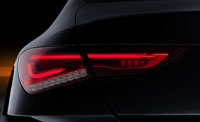
Additionally, the new CLA boasts muscled up side panels with flared fenders, while its entire roofline has been positioned farther toward the rear for a more traditional GT design. The more conventional look continues at the back thanks to a rectangular trunk cutout between totally new LED tail lamps that, like the lenses up front, are narrower and laid out higher and more horizontally for a wider overall appearance. Not only fresher and arguably better looking, the extensively wind tunnel-tested 2020 CLA is now much slicker through the air resulting in a 0.23 coefficient of drag.
“As a four-door coupe, the new CLA intrigues with its puristic, seductive design and sets new standards in the design DNA of ‘sensual purity’. It impresses with its perfect proportions reflecting the first design sketch: a long, stretched hood, a compact greenhouse, a wide track with exposed wheel arches and our typical GT rear with a strong distinctive ‘Coke-bottle shoulder’,” said Gorden Wagener, Chief Design Officer of Daimler AG. “In short, the CLA Coupe has the potential to become a modern design icon.”
The updated CLA’s interior is obviously focused on a younger customer, the vivid orange highlights of the show car and sizeable conjoined digital displays right out of the iPad, Surface and Galaxy Tab playbooks. The fixed-freestanding widescreen combination includes a gauge cluster to the left, which removes the need for an instrument hood altogether, and an infotainment touchscreen to the right, the latter controlled by Mercedes’ trademark palm-rest and new touchpad (the scrolling wheel is gone) on the lower console.
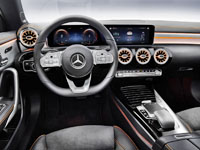
Do-it-yourself shifting comes via a set of paddles behind the 9 and 3 o’clock positions of the beautifully detailed leather-clad flat-bottom sport steering wheel, while above the previously noted infotainment controller is an elegantly thin climate control interface. Lastly, if that mammoth display didn’t first tug at your eyeballs, the stunning turbine-style circular HVAC ducts across the dash certainly should have.
Back to the mother of all in-car electronic interfaces, which was actually introduced in the new A-Class a year ago and E-Class before that, the graphically stimulating multi-information display and surrounding digital dials sits next to Mercedes new high-resolution MBUX infotainment system as noted earlier. Along with fully customizable displays, Augmented Reality navigation that reportedly provides a much more realistic mapping system plus more, the new system’s computing power is greatly enhanced over the CLA’s outgoing system, and even features software that can “learn and respond to natural speech,” said Mercedes-Benz.
If you’ve ever struggled to get a voice activation system to understand your prompts you may be glad to hear this next bit of news, because M-B’s new voice assistant is said to communicate more closely to Amazon Alexa, with the simple prompt of “Hey Mercedes” leading to more capability than any other in-car voice system offered thus far. What’s more, it’s intelligent enough to recognize the speech patterns of the individual asking the question, even when others are engaged in a different conversation.

“The latest version of voice control for MBUX – the Mercedes-Benz User Experience – can be experienced in the new CLA. For example, the voice assistant ‘Hey Mercedes’ is able to recognize and answer considerably more complex queries,” said Sajjad Khan, Member of the Divisional Board of Mercedes-Benz Cars for CASE and Head of Digital Vehicle & Mobility. “What’s more, the voice assistance no longer gets confused by other passenger’s conversations. Instead it only responds to the commands of the person who last said ‘Hey Mercedes’ to activate the system.”
Additionally, Mercedes says their new MBUX voice assistant can even recognize and respond to more complex indirect questions, such as “Find Italian restaurants with at least four stars that are open for lunch but exclude pizza shops,” for example. It can also manage a greater assortment of subjects, with other press release-cited examples including “Hey Mercedes, How did the Toronto Raptors play?” when referencing sports news, or “How has the Apple share price performed compared to Microsoft?” for its take on business news. If you need a quick calculation, MBUX can do that for you too, with the example given being, “What is the square roof of 9?” while Mercedes provided the questions “How big is Texas?” and “What is the fat content of avocados?” for the general knowledge category.
While some potential buyers may ante up for the new CLA just to for MBUX alone, plenty of others will appreciate the car’s larger overall size. It now measures 48 millimetres (1.9 inches) longer at 4,688 mm (184.5 in), while its wheelbase has been stretched by 30 mm (1.2 in) at 2,729 mm (107.4 in). Additionally, it spans 53 mm (2.1 in) wider at 1,830 mm (72.0 in) without the side mirrors, and finally its roofline is 2 mm (0.1 in) lower at 1,439 mm (56.6 in).
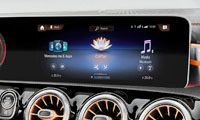
As you can guess it’s more accommodating inside, but while those up front enjoy 17 mm (0.6 in) of additional headroom, and rear passengers get 3 mm (0.1 in) more space overhead, whereas shoulder room has been improved by 9 mm (0.3 in) up front and 22 mm (0.8 in) in the rear, plus front to rear elbow room grows by 35 and 44 mm (1.4 and 1.7 in) respectively, front legroom has actually shrunken by one millimetre, while legroom in the back seat lengthens by just a single millimetre as well.
The cargo compartment is smaller too, but just by 10 litres (0.3 cubic feet) to a still-sizeable 460 litres (16.2 cu ft), while on the positive the new CLA’s squarer trunk lid width increases by a whopping 262 mm (10.3 in), plus the load floor was widened by 113 mm (4.4 in) wider and deepened by 24 mm (0.9 in).
Lift the opening at the other end and you’ll once again find a 2.0-litre turbocharged four-cylinder engine underneath, and while Mercedes hasn’t shared performance figures for its most affordable CLA 250 variant yet, it will likely measure up to the new A 250 Hatchback, which makes 221 horsepower and 258 lb-ft of torque for a 13 horsepower gain and identical twist. Putting power down to the front wheels or 4MATIC all-wheel drive is Mercedes’ in-house 7G-DCT twin-clutch automated gearbox, with a beefed up version of the transmission and standard AWD expected to be included in the (finger’s crossed) AMG variant, the current performance model good for 375 horsepower and 350 lb-ft of torque.

An increased dimension not yet mentioned is track width, which is up a healthy 63 mm (2.5 in) at the front wheels and 55 mm (2.1 in) in the rear, while the CLA also benefits from a lower centre of gravity, all of which should combine for a big improvement in overall performance. Additional chassis improvements include a Direct-Steer system and hydromounts up front, while the rear suspension includes a decoupled multi-link axle that reduces NVH, plus bigger stabilizer bars for reducing body roll. Lastly, 18-inch wheels shod in 225/45 tires should come standard, while 19-inch alloys wearing 225/40 rubber will be available.
And what about advanced driver assistance and safety systems? Standard with the CLA will be Active Brake Assist, while Active Lane Keep Assist, which helps to centre drivers within their lane and prevents them from unexpectedly veering off the road, will be optional by choosing the Intelligent Drive Package that also incorporates Pre-Safe Plus with rear traffic warning and an automatic backup braking system.
Also notable, the Intelligent Drive Package, which debuted in Mercedes’ flagship S-Class, can pilot the CLA autonomously in certain circumstances, but Mercedes is quick to point out that this semi-autonomous system still needs “cooperative driver support,” or at least it will until its many advanced functions are allowed to work on their own.
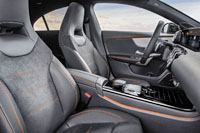
Produced in Kecskemét, Hungary, the redesigned 2020 Mercedes-Benz CLA should help increase Mercedes’ command of the subcompact luxury car market when it joins the new A-Class sedan for autumn 2019 availability (find new A-Class Sedan and Hatchback pricing and more right here on CarCostCanada now), not to mention the A-Class Hatchback, GLA-Class subcompact crossover SUV and who knows what else (but according to Mercedes more are coming), and by so doing secure an entirely new generation of three-pointed star devotees.
Story credit: Trevor Hofmann
Photo credit: Mercedes-Benz

